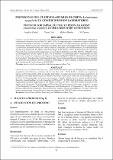Por favor, use este identificador para citar o enlazar este ítem:
https://hdl.handle.net/20.500.12958/3534Registro completo de metadatos
| Campo DC | Valor | Lengua/Idioma |
|---|---|---|
| dc.contributor.author | Castro Fuentes, Angelica Maria | - |
| dc.contributor.author | Cota Mamani, Noemí | - |
| dc.contributor.author | Montes, Melissa | - |
| dc.contributor.author | Carrera Santos, Lili | - |
| dc.contributor.editor | Instituto del Mar del Perú | - |
| dc.date.accessioned | 2021-04-14T02:50:57Z | - |
| dc.date.available | 2021-04-14T02:50:57Z | - |
| dc.date.issued | 2021-03 | - |
| dc.identifier.citation | Inf Inst Mar Perú 48(1), 2021, p. 20-24 | es_ES |
| dc.identifier.issn | 0378-7702 | - |
| dc.identifier.uri | https://hdl.handle.net/20.500.12958/3534 | - |
| dc.description.abstract | La especie marina Anisotremus scapularis en Perú es conocida como chita o roncador, en Ecuador como corcovado y en Chile como sargo, pertenece a la familia Haemulidae. Habita en las costas del Pacífico Sur desde Perú hasta Antofagasta Chile. Especie bentopelágica y carnívora es altamente valorada en el Perú, donde se comercializa principalmente fresca. Los desembarques anuales han disminuido los últimos años hasta llegar a 190 TM en el 2017. El Laboratorio de Cultivo de Peces del Área Funcional de Investigaciones en Acuicultura del Instituto del Mar del Perú - IMARPE, inició las investigaciones de esta especie el 2013, con el proyecto “Acondicionamiento y Reproducción de chita Anisotremus scapularis” como parte del Programa Presupuestal (PpR) Nº 0094 “Ordenamiento y Desarrollo de la Acuicultura”. Basado en las experiencias obtenidas y los resultados de diversas investigaciones se presenta este protocolo con el objetivo de dar a conocer la metodología de cultivo durante la etapa larval desarrollada en el laboratorio de Cultivo de peces del IMARPE. | es_ES |
| dc.description.abstract | ABSTRACT: In Peru, Anisotremus scapularis is known as Peruvian grunt, while in Ecuador and Chile it is called corcovado and sargo, respectively. It belongs to the family Haemulidae and inhabits the South Pacific coast from Peru to Antofagasta, Chile. In Peru, this benthopelagic and carnivorous species is highly valued and it is mainly marketed fresh. Recently, annual landings have decreased up to 190 t in 2017. In 2013, the Fish Culture Laboratory of the Aquaculture Research Department of the Instituto del Mar del Perú - IMARPE, started research on this species with the project "Conditioning and Breeding of Peruvian grunt Anisotremus scapularis" as part of the Budgetary Program Nº 0094 "Management and Development of Aquaculture". We present this protocol based on the experiences obtained and the results of several investigations. We aim to show the culture methodology during the larval stage developed in the IMARPE's fish culture laboratory. | - |
| dc.language.iso | spa | es_ES |
| dc.publisher | Instituto del Mar del Perú | es_ES |
| dc.relation.ispartofseries | Informe IMARPE;48(1), 2021 | - |
| dc.rights | info:eu-repo/semantics/openAccess | es_ES |
| dc.rights.uri | https://creativecommons.org/licenses/by/4.0/ | es_ES |
| dc.source | Instituto del Mar del Perú - IMARPE | es_ES |
| dc.source.uri | Repositorio Digital IMARPE | es_ES |
| dc.subject | Anisotremus scapularis | es_ES |
| dc.subject | Chita | es_ES |
| dc.subject | Cultivo | es_ES |
| dc.subject | Larvas de peces | es_ES |
| dc.title | Protocolo del cultivo larvario de chita Anisotremus scapularis en condiciones de laboratorio | es_ES |
| dc.title.alternative | Protocol for larval culture of Peruvian grunt Anisotremus scapularis under laboratory conditions | es_ES |
| dc.type | info:eu-repo/semantics/article | es_ES |
| Aparece en las colecciones: | Informe vol. 48(1) 2021 | |
Ficheros en este ítem:
| Fichero | Descripción | Tamaño | Formato | |
|---|---|---|---|---|
| Informe 48-1 Articulo5.pdf | 1,14 MB | Adobe PDF |  Visualizar/Abrir |
Este ítem está sujeto a una licencia Creative Commons Licencia Creative Commons

